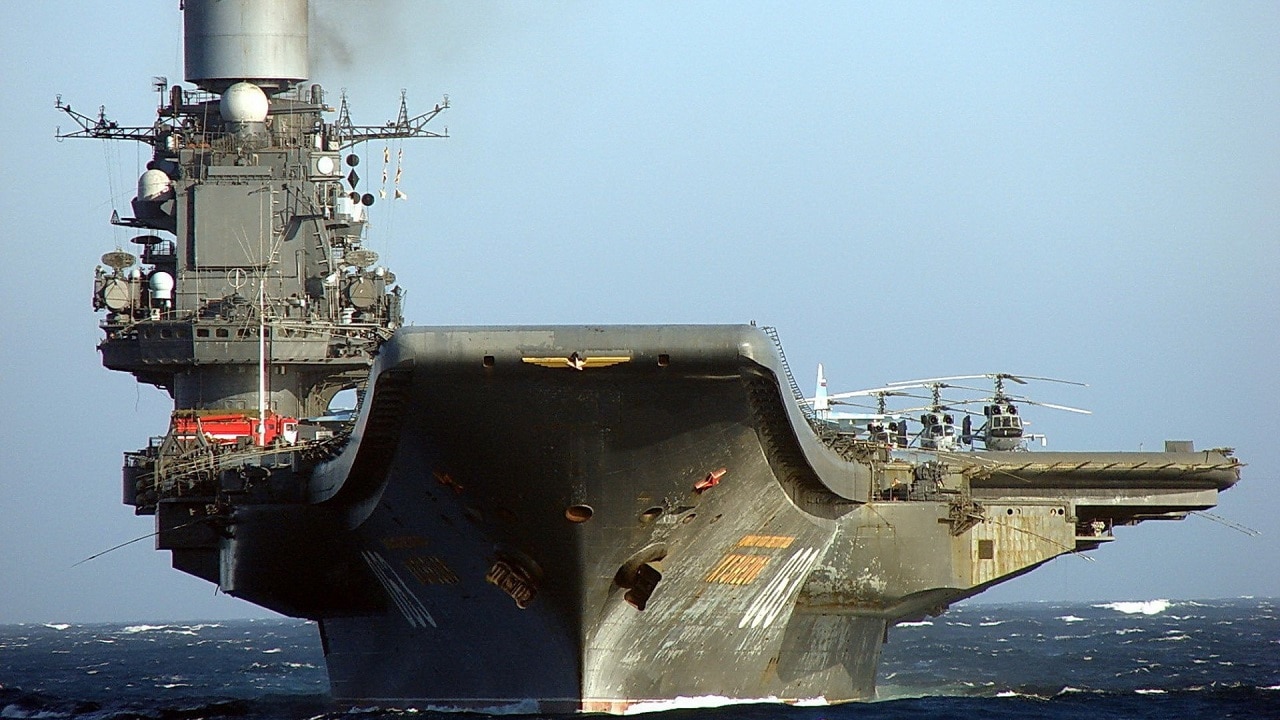The Admiral Kuznetsov is once again making headlines for all the wrong reasons.
The Ukrainian Defense Ministry is claiming that the troubled vessel, Russia’s only carrier, cannot sail under its own power. The Admiral Kuznetsov has been in dry dock for maintenance and repairs since 2017, with the Russian navy insisting it will deploy again in the future.
But the future is now, and this carrier is obviously jinxed.
Admiral Kuznetsov: A Carrier of Constant Sorrow
The Ukrainians believe the carrier is now under a state of emergency. Workers are struggling with the ship at the Zvyozdochka shipyard in the Barents Sea port city of Murmansk. The Russian navy tried to send it to another dry dock, but somehow the engines are not working correctly, leaving the vessel stuck. The ship’s hull reportedly has a problem, and tugboats are struggling to move it.
It gets worse. Ukraine’s Defense Ministry said the carrier could “tip over and sink,” according to Newsweek. Divers examining the hull found dangerous levels of corrosion and the holds are totally filled with water, the magazine said.
The list of troubles for the Admiral Kuznetsov is long, and 19FortyFive has chronicled its problems extensively. Most recently, the ship had another fire in December, although this one did not cause any casualties. It often breaks down mid-mission, and tugboats have to accompany the carrier on deployments. It lost two airplanes during Russia’s intervention in Syria. It belches black smoke due to its use of a messy fuel called mazut, giving the ship an appearance of ill health.
Over a Century of Naval Struggles
Those are all minor problems compared to the death toll on board the ship. In 2018, a floating crane fell on the carrier’s deck, killing one worker and injuring four others. In 2019, a fire broke out in the engine room, sparked by a welding mishap. Two employees died and 14 were treated for smoke inhalation and burns. This incident caused $8 million in damages. In another embarrassment, at least one official was caught embezzling from the shipyard.
This is getting ridiculous and is a humiliation to Russia. Vladimir Putin must be furious. The carrier will probably never sail again, and it shows the weakness of the Russian navy and its maritime defense industry.
Except for its formidable submarine fleet, the Russian navy is often an afterthought compared to its army. Its consistent struggles date back to the disastrous Battle of Tsushima against the Japanese in 1905. More than 20 Russian ships were sunk or captured in that engagement, and the fleet was destroyed.
Barring its submarines, Russia has a green-water, not a blue-water fleet. This means its naval vessels can only protect the homeland. They do not regularly venture beyond friendly shores. Russia does not have a network of naval bases around the world that would allow it to project power. There is the small naval facility at Tartus in Syria, but this is more for light maintenance and technical support – it’s not a full-fledged base.
Mediocre Wartime Performance
The Russian navy has shown over the course of the war in Ukraine that it still does not have its act together. Its Black Sea flagship Moskva, a jewel of a missile cruiser, was sunk by Ukraine last April. The navy never conducted a shore landing to take Ukrainian cities such as Odesa. Russian ships often stay out of range of Ukrainian anti-ship weapons and fire missiles for ground strike missions against Ukrainian critical infrastructure. Aside from these missile launches, the navy has not been a decisive factor during the war.
As for the Admiral Kuznetsov, it should probably be scrapped. Russia has a better chance at starting over and building a new carrier than trying to salvage this cursed vessel.
Author Expertise and Experience: Serving as 19FortyFive’s Defense and National Security Editor, Dr. Brent M. Eastwood is the author of Humans, Machines, and Data: Future Trends in Warfare. He is an Emerging Threats expert and former U.S. Army Infantry officer. You can follow him on Twitter @BMEastwood. He holds a Ph.D. in Political Science and Foreign Policy/ International Relations.

